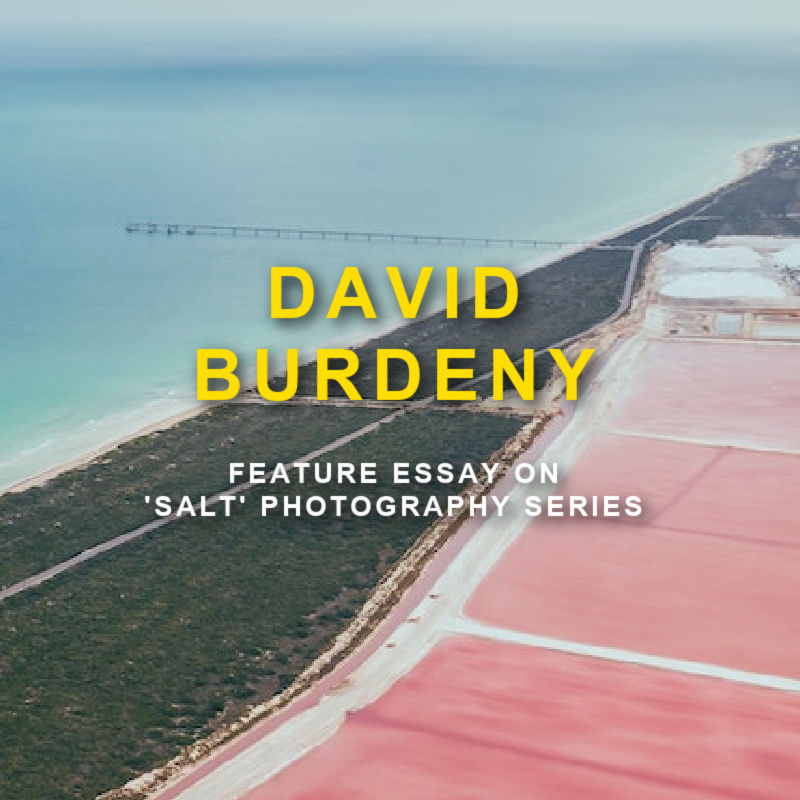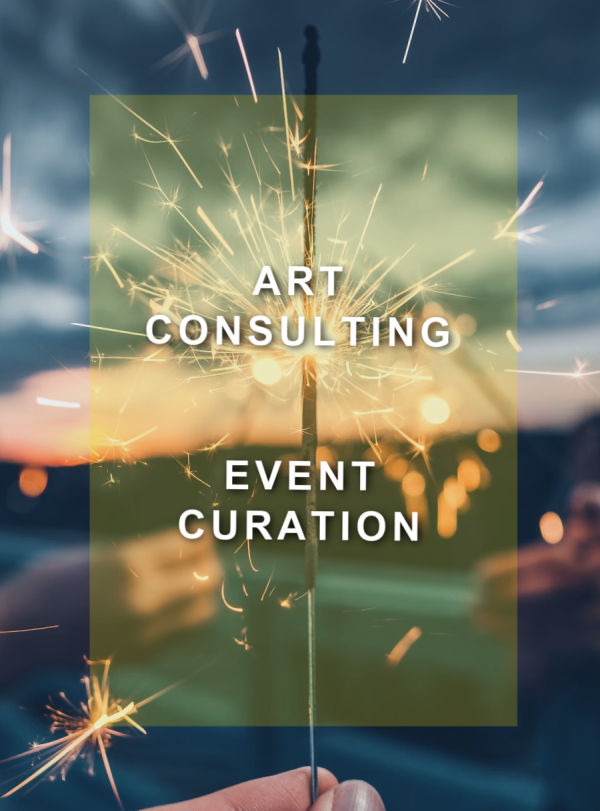PROJECT

FEATURE ARTICLE
DAVID BURDENY
The Salt Series
– ABOUT THE PROJECT
A highly regarded and influential landscape photographer, David Burdeny has a keen eye for the aesthetic intrigue in the world around us. Honoured 3 times as International Fine Art Photographer of the Year at the IPAs, Burdeny’s many thematic series – including on arctic topography, prairie architecture and Moscow’s modernist metro stations – all pay exquisitely precise attention to liminal places. Real world places that almost seem part of a fantasia. I appreciated hearing David’s stories of being up in the air, over and over, as he prepared the work for the series Salt which features sweeping aerial views of colourful salt pools. His visceral experience of these scenes was a key to understanding the emotional value in the work.

“In their use of amorphous shapes, elongated fields of colour and vertical, jagged and sinuous lines, Burdeny’s images suggest the painterly expressiveness of Rothko, Still, Newman, Diebenkorn and late career Willem de Kooning. The effect is less intentional than it is available – Modernism’s abstracted reordering of the visual landscape (which essentially got going in pre-WWI Paris with Robert Delaunay and his aerial scenes of the Eiffel Tower) permits a non-objective reading of these compositions.”
– Barry Dumka
FEATURE ARTICLE
DAVID BURDENY
The Salt Series
In 1858, Gaspard-Felix Tournachon – known with a flourish as ‘Nadar’ – mounted a wet-plate collodion camera to a giant gas-powered balloon, becoming the first to take photography to aerial heights. Jules Verne called Nadar, “an Icarus with replaceable wings.” The lofty spirit of this industrious age was animated by the potential for height- people were eager to go up high. But the noted caricaturist Honore Daumier – typically the century’s most incisive social chronicler – doubted that there was anything aesthetically beneficial to be gained from such a lofty perspective. Daumier’s famously satirical lithograph, Nadar Raising Photography to the Height of Art, was intended as a mockery of aerial photography’s artistic pretence and as a warning against its surveillance purpose. Daumier’s print shows Nadar rising high above Paris with his camera pointed down and every building below target-marked by the word “PHOTOGRAPHIE”. Already, the utility of panoptic vision was thought to trump its sublime allure or transcendental opportunity. And it would take another 50 years before this fundamentally ne w visual perspective – the world seen from above – would upend artistic representation of space.
That tension between utilitarian purpose and artistic inspiration is the unexpectedly compelling strength of David Burdeny’s mesmerizing series of aerial abstractions called Salt. Burdeny’s large format and luminously intriguing photographs of salterns occupy the hazy borderzone between the prosaic and the poetic. In our hyper-connected age of GPS, Google maps and instant information, the instinctual reaction to these scenes might be to determine the where and the why of them – their ground level location or biological fact. To see first the service roads and draining ditches or to puzzle out how the chemical balance in the salt ponds creates these particular blooms of colour. Such readings serve to root vision in the commonplace and established order – the here and now – and downgrade the sublimity in the aerial experience. But Burdeny’s Salt photographs aim to be more evocative and exalted than pedestrian. They seek to elevate our knowledge and experience of the world in more ways than one.
From the start of his fine art photography career – certainly aided by his earlier architectural practice – Burdeny has always had a deft appreciation for the artistic potential of pure space and how it can be purposefully structured to appeal to the senses. He has become a master of the photographic moment made in service of a sublime sensibility. His early black-and-white long-exposure work created a minimalist monumentality out of spare landscapes that felt privately spiritual and seemed to exist outside time. And the stark awesome force of the icebergs in his North/South series crackled with a similar terrifying majesty as the Romantic poets and artists of the nineteenth century regarded them. Even the docents sitting alone and attentively in the Hermitage in Burdeny’s recent Bright Future series seem to be keenly aware of the profound privilege of sensuous perception.
What Salt adds to this conversation is its cunning use of the artistic heritage and sublime intrigue of abstract art to further Burdeny’s interest in liminal spaces. In their use of amorphous shapes, elongated fields of colour and vertical, jagged and sinuous lines, Burdeny’s images suggest the painterly expressiveness of Rothko, Still, Newman, Diebenkorn and late career Willem de Kooning. The effect is less intentional than it is available – Modernism’s abstracted reordering of the visual landscape (which essentially got going in pre-WWI Paris with Robert Delaunay and his aerial scenes of the Eiffel Tower) permits a non-objective reading of these compositions. But why bother? What do we gain by seeing landscape as a non-objective experience or colour as an “instrument” (as Rothko termed it) to explore subconscious emotions? In his 1948 essay, The Sublime is Now, Barnett Newman provided the essential answer -”the image we produce is the self-evident one of revelation”. And that power of personal revelation remains an active concern in contemporary art. A recent 3-year scholarly survey by the Tate revealed how actively engaged is the field of artists presenting new ways to consider the sublime and the potential for “immanent transcendence,…a transformative experience”.
With Burdeny’s Salt series, once you let go of the map, you take hold of the opportunity in the work. Then the immensity of the view, the expressive power of light and colour, and complex feelings of solitude and release take over, take flight. Burdeny manages to render into visual form the ineffable experience of drifting, of floating above it all, of being lost out beyond the humanly order of things (a clever conceit given how humans have definitely ordered these working salt fields). In some of the images – such as Saltern Study 15 – there is the sense of the transfigurative potential of expansion, a longing for the infinite. Whereas Red Water, Hut Lagoon reveals the awesome beauty of the abyss as a roiled cauldron of red. In their abstracted glory, Burdeny’s images play to the psyche and have powerful emotional force.
The legend of Icarus is often told as a parable of hubris defeated but it can equally be read as a transformational text – as the triumph, however temporary, of emotion over reason. Once airborne, up and away from the regular order of life, Icarus experienced exhilaration and the ecstasy of an altered perspective. While cultural tradition duly notes that Icarus fell back to earth, perhaps we should make more of how amazing it must have been while he was up there. Fortunately, Burdeny has used his camera to give witness to the continuing resonance of such transcendental revelations.
- Barry Dumka
© Barry Dumka/BCREATIVE CONSULTING
Our Services
Copywriting + Ghost Writing
What you say matters.
BCreative Consulting provides our clients a wide range of written and ghostwritten material to achieve their messaging goals. The key is to write with an audience in mind. Emotion, authenticity and storytelling all play a part in capturing the attention and loyalty of others.
For artists, personal brands and small businesses, the story of their creative individuality - the vital core of their identity - is a powerful opportunity to connect what they do with others. Your audience wants to be informed and inspired. Go at it with gusto.
Content Creation + Marketing
What you share matters.
BCreative Consulting works with our clients to shape the image and stories they share in this social media-fuelled marketing age. Digital storytelling is one of the most effective methods for growing audience engagement, developing your brand presence and driving sales. Compelling content earns you stature, inspires trust and stokes curiosity and loyalty. But you have to think about your audience as much as yourself. Still, even the most personal stories can have universal appeal. Be relatable and be inspiring.
Art Consulting + Event Curation
What others experience matters.
BCreative provides art consulting and event curation services for select projects to create aesthetically appealing and client-focused experiences. With extensive art consulting and project management experience for residential, commercial and hospitality projects throughout North America, we know the vision and strategic choices necessary to create exceptional art collections. Sales-focused creative events also require strategic planning and a purposeful vision. To create lasting value, it's essential to make a beautiful first impression.
QUESTIONS?
As a freelance creative consultancy, BCreative Consulting gets involved in many unique projects specific to the needs of our clients. We enjoy insightful conversations, positive client relationships and heralding the authentic meaning and value at the core of all creative efforts. It’s a powerful opportunity – and a great challenge – to inspire an audience. And we love being part of that process.
Do you have a project that needs some strategic help? Or a good story?



